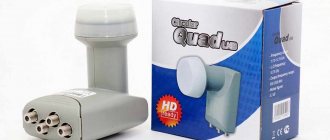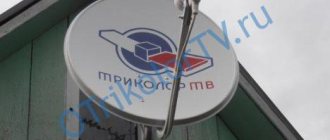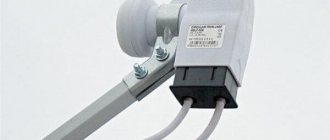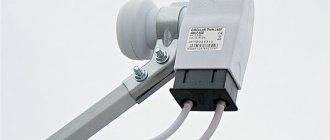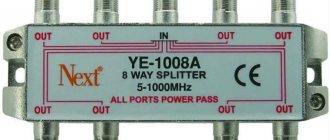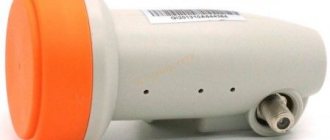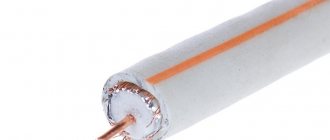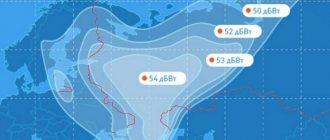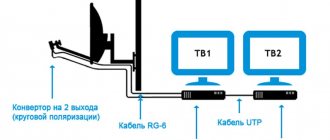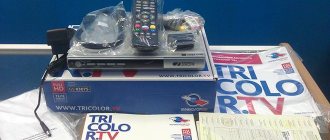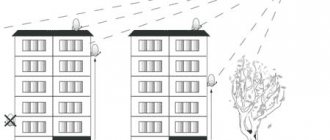Looking at the antenna unit for receiving satellite broadcasts, many users mistakenly consider the main part to be a large and noticeable dish. In practice, the most important component is the Tricolor converter. It is he who is engaged in converting radio waves reflected from the deflector into an output signal to the receiver. Understanding the operating principle of this unit will allow you to choose the best converter for Tricolor TV and decide which model is worth buying to connect the required number of TVs in the house.
Purpose, design and principle of operation of the converter
The converter for Tricolor TV is a compact, lightweight device. It is considered to be a single unit. But in practice, a converter with 2 outputs, 4 outputs or an advanced device with 8 outputs consists of pairs of functional blocks. It all works as follows.
- The signal coming from the satellite is amplified. A separate converter block is responsible for this. Its characteristics directly indicate the ability to generate high-quality indicators of the output signal. The noise level parameter, measured in decibels, formally indicates the distortion introduced by the device. Based on a value of 0.3 and below, you can choose a converter for Tricolor TV HD that can provide excellent picture quality.
- The second block converts the wave signal into the parameters necessary for the operation of the receiver. It also brings the broadcast to the standard adopted for conditional access televisions and other equipment capable of working with satellite signals.
Within the framework of one converter, a variety of construction schemes from the described modules can be implemented. The minimum characteristics of the final node that is needed for Tricolor is a pair of an amplifier and a wave converter with one output. The price of such a device is accessible to literally every consumer. If you need to send a signal to 2 TVs or more, you need to buy a more complex converter model.
Converter parameters for Tricolor TV
In addition to the already indicated noise level, the head for the Tricolor plate is selected according to a number of parameters. Some of them are critical for receiving broadcasts from this particular satellite television provider.
Frequency range
Each converter operates with a specific frequency band. It is better for Tricolor to choose a device that meets the broadcast standard of all Russian satellite television providers - this is the so-called KU range.
Polarization
Tricolor broadcasts in circular polarization. Converters of another type, linear, are not suitable for receiving broadcasts from this provider. Polarization is indicated directly on the device body. The inscription Circular means circular, and Universal means most often not suitable for Tricolor subscribers.
Number of outputs
As mentioned above, to watch programs on one TV, a converter with a single output is sufficient. If there are two or more TVs in the house, it is recommended to buy a device with the required number of ports. There is no need to skimp on this feature. Splitters - dividers in some cases cannot provide adequate signal quality to the consumer.
Noise level
Today the Tricolor company offers channels in UHD quality for viewing. The requirements for receiving such a signal are very high. If a subscriber plans to subscribe to HD and UHD channels, he will need a low noise LNB (LNA) converter.
Many manufacturers claim a noise level of 0.1-0.2 dB for such a device. However, this is most often a marketing ploy, and in practice the figure ranges from 0.3 to 0.5 dB. It is this range that you should focus on in order to buy a device with the optimal price-performance ratio. A simpler converter is suitable for receiving regular broadcasts. The permissible noise level ranges from 3 to 5 dB. The price of such products is very affordable.
Manual setup of Tricolor TV - subtleties and tips
When manually tuning television, the user should find out in advance the correct frequencies of the desired channels. To do this, you should visit the official website of the satellite company or call the contact center.
If making a call is inconvenient, you should specify the following parameters:
- frequency – 12226, flow speed – 27500, polarization – left;
- frequency – 11727, speed and polarization are the same as indicated above;
- frequency – 12303, speed – 17500, polarization – right;
- frequency 12174, speed – 04340, polarization – right.
Additionally, it is recommended to activate the option that offers to skip encrypted channels. This approach will allow you to remove unavailable TV channels from the list and make switching between broadcasts as convenient as possible. We recommend that you familiarize yourself with the list of free Tricolor TV channels in more detail.
If difficulties arise, you should make sure that the date and time are correctly specified in the receiver settings. A typo or inaccuracy will result in some of the broadcasts being unavailable.
Converter or splitter: which is better to choose?
Splitters, also known as signal dividers, are simple devices with one input and several outputs. In the eyes of many consumers, they look like a cheap alternative to laying cable lines and buying a converter with the required number of outputs for TVs installed in the house. In practice, using splitters can lead to negative results. Broadcasts in HD quality are extremely sensitive to signal level. For splitters, it is lower at each output than at the input. As a result, the following happens:
- some TVs do not show all channels of an active subscription;
- On HD channels, video glitches occur, the picture has artifacts, freezes, and crumbles.
Approximate prices for converters
Thanks to the achievements of Chinese and other industries, the price of the converter is continuously falling. Today you can buy:
- solutions with one output; for Tricolor, the SLWI-51EN model with an average price tag of 500 rubles is recommended;
- a device with two General Satellite TWIN outputs for an average of 780 rubles;
- solution for 4 outputs, model GSLF-54E with an average price tag of 1800 rubles.
For those who plan to equip a large house with TVs in every room, there is the Galaxy Innovations GI-128 OCTO model, which has as many as 8 independent outputs. At the same time, the device is low noise and suitable for receiving HD channels. The price tag for such a converter is about 2150 rubles.
However, most users prefer to take the easiest path. To buy a converter with optimal characteristics, just contact authorized dealers or a Tricolor subscriber service branch in your region. Experts will recommend a model that shows the best results in this particular area.
How to check the converter during installation
Tricolor converters purchased from official dealers or ordered from the company's customer service branches are almost always of high quality. However, if the device was purchased from third-party companies, ordered from online stores, or purchased on global trading platforms, you should make sure that it is working. You can check the satellite dish converter as follows:
- install it on the deflector posts;
- connect a specialized device to the device, for example, Satfinder for setting up satellite dishes and check the indicator readings;
- If you do not have a setup device, switch the receiver to the signal indicator display mode and make sure the converter is working.
Another way to check the converter is to connect it to an already installed and correctly configured deflector and Tricolor receiver.
In case of any problems, lack of signal, reception of some channels, first eliminate all possible problems in the form of an incorrectly inserted card, old receiver firmware, damaged cables and other problems. Only then do they decide that the cause is a broken converter. This may be indicated by:
- some channels do not show with the error “No signal”;
- on the channel information banner, one of the indicators shows a normal value (signal strength), and the other (quality) shows zero.
The Tricolor converter cannot be repaired; the device must be completely replaced. It is recommended to order a high-quality, certified converter from authorized dealers or Tricolor customer service branches. But if you are confident in your ability to make the right choice, you can buy a suitable model from third-party sellers.
Good afternoon friends and everyone who accidentally visited the channel. Today I want to share my experience of setting up a satellite dish to view the most popular operators in Russia: NTV+ and Tricolor. I will try to explain as simply as possible how you can set everything up yourself.
In general, the procedure is quite simple, you just need to approach the matter correctly and obtain the necessary minimum knowledge. If you are able to independently screw a bracket to the wall of the house and drill a hole in the wall, then you do not need a specialist.
Suppose you purchased a set of equipment, you need to check everything necessary for connection according to the list:
- Satellite receiver NTV+ (Tricolor) with contract.
- Circular polarization converter.
- Satellite dish (60 cm for the European part of Russia).
- Bracket for wall mounting.
- Connection cable and connectors.
The only non-standard equipment you will need is a compass, for example this one.
So let's get started.
The first step is to determine the location where the antenna will be installed. Let’s calculate the direction in which the plate will “look”; for this we will use one of the online programs on the Internet.
Each region will have its own angles of inclination and rotation, I will calculate it using Moscow as an example.
In the bottom picture we see how and where to point the antenna. Using a compass, we find the direction to the north and set aside the required azimuth. As you can see, in Moscow it is almost due south. In addition to the tilt angles, the program gives us “converter rotation”, we don’t pay attention, this is not relevant for NTV+ (Tricolor).
We assemble the antenna according to the instructions; screwing anything in the wrong place is quite difficult. After understanding where the antenna will be directed (we check it with a compass), we attach a bracket to the facade of the house, but be sure to have sufficient ability to move the “dish” right and left up and down for adjustment.
Next, we attach the converter to the holder.
At the same time, we check that they sold us exactly the circular polarization converter (for NTV+, Tricolor), another one will not work. Something like CIRCULAR LNB should be written on the packaging or case. We screw it to the antenna and secure the wire.
You can now put the “plate” on the bracket, point it approximately in the desired direction and slightly tighten the fasteners so that it can still be moved, but with force.
The next step is to connect the satellite receiver to the TV; to set up the antenna, you will need to bring it and the receiver into view. Those. To configure, you need to move the antenna and immediately look at the screen, monitoring the signal level.
We connect the antenna to the satellite receiver - the socket labeled LNB IN.
Before you rotate the antenna, you need to tune the receiver.
It is very important to correctly register all the parameters of the antenna in the settings, otherwise it is useless to twist and look for something. Any receiver has antenna settings, first of all we indicate the local oscillator frequency (LNB), usually it is 10750, we read what is written on the packaging of the converter or on it itself.
We register it in the receiver settings.
Whatever model you have, the settings are the same everywhere.
And the second step is to indicate the transponder on which we will “catch” the signal.” The signal from the satellite is divided into conditional transponder beams; you need to specify the correct parameters of the existing beam, otherwise the receiver will not “see the signal”. Usually in the receiver you can select a satellite from the list of available ones and there is already a list of transponders there. Or, alternatively, specify manually.
If in doubt, you can check the current table of transponders online on the website.
For example, from the picture you can see that on the transponder 12265L 27500 3/4 there is an unencoded Shopping Live channel, I also circled the letter “F” - Free i.e. free viewing.
You can enter, for example, these parameters 12265L 27500 3/4. That's it, now you can rotate the antenna 
We leave a window in the receiver with the signal level and the entered transponder, spin the plate and monitor the signal on the lower two scales - intensity and quality.
The signal from the satellite is digital, which means it’s enough to move it by 1-2 mm and the signal disappears, so we very slowly move the “dish” left and right, change the elevation a little and again slowly left and right. If a signal appears only on the intensity scale, this is interference; the signal will actually be broadcast when the quality scale is filled. If you find a signal, great, try to achieve 100% on two scales, if you get no more than 60-70% with a high probability in rain and bad weather the picture will be disrupted. You need to check if there are any obstacles in the signal path: tall buildings, trees, etc. In some cases, the satellite will have to be abandoned.
I hope everything worked out for you and you managed to achieve results no worse than mine. Now we twist the antenna and take the set-top box with the TV into the house. On the set-top box, we turn on the auto search mode, save hundreds of channels and enjoy an excellent digital picture in any wilderness.
I hope I didn’t bore you too much and loaded you with numbers, in reality everything is not as difficult as it seems, the road is given to those who walk 
If you have any questions, I’m ready to discuss them in the comments.
Having decided to connect satellite television from NSC, potential subscribers of the operator will definitely be faced with the need to purchase equipment. As a rule, choosing a TV and receiver does not require special technical knowledge. But in order to understand what kind of converter is needed for Tricolor TV, you will need to at least remember a course in elementary physics.
How to set up a tricolor convector
Author: Administrator incl.
March 22, 2012. Published in Do It Yourself The photographs below refer to my design of the converter holder, since in some satellite antenna designs there is no adjustment described below at all, but usually similar designs work on the same principle. And the main thing is not this, but to convey to you, for the future, the basic principle of this setting.
The converter holder on my satellite dish is secured with one bolt and nut. If you loosen them, then this holder, together with the converter itself, can be brought closer or further away from the spherical mirror of the satellite antenna, moving them in a certain plane (Photo 1).
To make this possible, the manufacturer made a longitudinal hole in the pipe itself on which the satellite converter holder is attached (Photo 2).
Why do we need to adjust the distance between the converter feed and the reflective surface of the satellite dish mirror?
The point here is that the beam focused by the satellite antenna mirror must fall into the center of the converter feed. When you place the converter itself on an L-shaped holder, the reflected and focused signal beam can only fall on the edge of the feed. For example, on the top edge of the irradiator (Photo 3), or on the bottom (Photo 4).
So we must make the adjustment so that the signal hits exactly the center of the feed. But since we cannot see the signal itself, we will make this adjustment, again, according to the indicator of the level and quality of the signal of the satellite receiver. That is, according to its maximum indicator.
To begin with, remember on the indicator itself the percentage level of the satellite signal. We will do this so that when setting up the converter, we will cover with our hands part of the signal flow itself. Move the converter, for example, towards the satellite dish mirror, in small steps until it stops. From time to time, remove your hands from the converter and look at the signal level. Do the same thing, moving the converter to the other side.
In general, find the position of the satellite converter in which the signal indicator readings of your receiver will be as maximum as possible.
Converter focus.
Setting focus.
To focus the satellite signal on the converter feed, loosen the screws that secure the converter itself to its holder. Loosen it so that it can move back and forth with little effort (Photo 1).
Photo 1
Your design of the converter holder may be different, but the principle of all settings will be the same.
The process of adjusting the focus is the same as in the centering I described above. Also remember the percentage signal level on the indicator. Move the converter, first in one direction, in small steps until it stops (Photo 2), do not forget to remove your hands from the converter body and look at the signal level. Do the same thing, moving the converter to the other side (Photo 3). And thus, find the position in which the signal will also be maximum.
Having placed the converter in focus and tightened the mounting bolt and nut, you can move on to another setting of the satellite converter. This will be the last stage of mechanical alignment of the satellite dish.
Converter position
Here we need to adjust the vertical position of the satellite converter. The process of this adjustment, again, is the same as when centering and adjusting the focus, which I talked about on the previous page, the only difference will be that we will carry out this adjustment in a different plane.
Grasp the converter body and rotate it on the holder in one direction. and then in the other direction (Photo 1), while being careful not to lose focus. Achieve maximum readings on the signal strength indicator. After adjustment, tighten the mounting screws.
Source
Basic parameters of converters for receiving satellite signals
Scientific sources define a converter as a receiver for processing a satellite signal. In fact, this is not one, but two devices in one monolithic block.
One of them is designed to enhance the signal coming from the satellite. Its operation is characterized by the level of (additional) noise produced. Everything is simple here - the lower the values, the less interference there will be during transmission. In modern devices, this parameter ranges from 0.3 to 0.5 dB. These are quite adequate indicators that fit the definition of “low noise device” or LNA (English abbreviation). Another name associated with the amplifier is the satellite converter - LNB or low noise unit.
Important: not very conscientious manufacturers indicate more attractive data (0.1 - 0.3 dB), but they should not be taken as truthful.
A second device is needed to convert wave frequencies. It leads them to parameters under which the signal can be transmitted to a receiver or TV with a conditional access module without instant attenuation in the cable.
Important: converters are only capable of operating with certain frequency ranges. This characteristic largely determines which converter is best to choose for Tricolor. The device must process the frequencies on which Russian operators broadcast - in the range from 10.7 to 12.75 GHz (the so-called Ki-band).
Polarization of converters for Tricolor
Having decided on the noise characteristics and operating range of the unit, you can move on to the next important parameter - the polarization of the satellite signal. The average satellite subscriber needs to know one thing - that it can be circular or linear (it differs among different operators).
Since Tricolor TV works with a circularly polarized signal, the converter must be selected accordingly. This can be concluded from the inscription “Circular” in the block name. On the contrary, a head marked with the word “Universal” is not initially suitable.
Appearance of Tricolor converters and number of outputs
The LNB unit, hermetically sealed in a metal casing, is placed in an L-shaped plastic case with a rounded cap at the end (hence the common name “head”). The mechanism is mounted on the remote rod of the antenna (so that the signal collected by the dish is focused directly on it). The unit is connected to the receiver via a coaxial cable.
Just by the appearance of the devices, you can determine that they differ in the number of connectors to which the coaxial cable is connected. The classic case is a converter for Tricolor TV with 1 output. An increase in the number of plugs makes it possible to connect not one TV to one satellite dish, but two or even more. Each of them will be able to work in tandem with its own receiver, that is, completely autonomously.
We recommend that you find out why Tricolor TV clients should sign a subscription agreement and where to find the form.
Read: how to install a Tricolor smart card and what it is needed for.
The number of outputs on the LNB can be judged by its markings:
- SINGLE - one;
- TWIN - two;
- QUAD - four;
- OCTO - eight.
Antenna operating principle
A satellite dish is a dish-shaped type of parabolic antenna (multifield, Opticum AX 1000+, Maximum, Opticum X80 Premium, Orton X80, BIG BISAT), designed to receive microwaves from communication sources that transmit signals to television, radio, and sometimes Internet satellites (Intelsat 15, Intel, Eutelsat 36A/36B (36°E), TT-budget S-1401 SkyStar 3, Sky tv digital).
The parabolic shape of the offset dish reflects the signal to the antenna at the focal point. A device called a horn feed (Satfinder) is attached to the dish coordinator; its adjustment is fully automatic. This part is essentially an amplifier, the front converter heads (LNB) collect the signals from the focal point and “drive” them to the down-converter block. The horn converts electromagnetic or radio wave signals into electrical waves and tunes their spectrum.
Now another amplification technology is actively used - winding a metal mesh or additional turns of wire on a plate (see photo). This setting helps increase the antenna's absorption capacity and sensitivity even to weak signals.
Modern dishes intended for use in home television typically range in size from 43 cm to 80 cm in diameter and are configured in one position to receive Ku-band from one orbital position. Before the existence of live broadcast satellite services, home users typically used a motorized C-band dish up to 3 meters in diameter to receive channels from different satellites. Overly small plates can cause network problems, but they have a longer shelf life, are easier to set up, and are durable.
Which is better – a multi-output converter or a splitter?
The price of the converter will directly depend on how many TVs can be connected to it. Obviously, a satellite converter with 4 outputs for Tricolor will cost more than a similar device with two connectors and cheaper than with eight.
In addition, ideally, there should be a separate cable from each F-connector of the head to each TV. This only increases the overall cost of multiple connections, especially when you factor in the additional installation. In this case, craftsmen suggest saving money by installing special cable dividers (splitters) directly on the approach to the receivers.
Practice shows that this method works with drawbacks. A decrease in the quality of signal transmission to the receiver is manifested in the following moments:
- one of the TVs does not show all the channels of the paid package;
- the picture, especially on HD channels, sometimes breaks up into squares, that is, “crumbles.”
Advice: as for Tricolor TV subscribers specifically, the 2-output converter is most popular with them due to the operator’s special offer. The server-client kit allows you to connect two TVs from one antenna and pay a single subscription fee.
What to do if the device does not work
A converter is a device for receiving a satellite TV signal; you can understand that it is not working based on the most important sign - the absence or decrease in the quality of the received signal.
It is very important, before blaming the converter for signal loss, to exclude all other signs:
- Bad weather. The signal may deteriorate for a short time, this is rare, but it does happen;
- Cable damage. Make sure there is no damage anywhere on the line;
- Poor contact. It can also cause signal quality deterioration. Check all connections and make sure there is no disconnection anywhere;
- Poorly installed subscriber card or insufficient funds in the account.
All these and other possible reasons for the lack of a signal should be excluded before touching the converter directly. The device is quite reliable and should not fail.
Where and how much can you buy a converter for Tricolor TV?
Before asking yourself how much a Tricolor converter costs, you need to decide how many cable connectors should be on board. The next point that significantly affects the price tag is the manufacturer.
And here, experienced users unanimously confirm that you should only beware of very cheap devices of Chinese origin. All other units with the necessary parameters for working with the satellite, which broadcast for NSC, perform well.
With the development of the World Wide Web, the problem of where to buy a converter for Tricolor practically does not arise. Various online stores vied with each other to offer satellite heads with the ability to send them to any corner of the country.
Advice: purchasing from an “unverified” place would be appropriate only if you have the knowledge and experience in selecting and installing such equipment. Otherwise, it is better to purchase from certified sales offices or official dealers of the operator. They will also tell you how to properly configure the Tricolor converter, and if necessary, they will carry out installation work.
Pros and cons of Tricolor TV without a dish
Tricolor without a plate gives subscribers the following advantages:
- free additional TV channels previously available for viewing on a paid basis or in certain regions;
- the ability to use the receiver anywhere there is an Internet connection;
- independence from weather conditions and other external influences to which satellite communications are sensitive;
- TV archive, content rewinding and other interactive TV functions.
The main disadvantages of Tricolor without a dish are the inability to use old models of equipment, as well as the direct dependence of broadcast quality on Internet speed. However, these technical issues are easily resolved.
The TV does not show - is the problem with the converter or not?
When channels paid for by the subscriber stop showing, the problem may lie in any link in the antenna-receiver-TV chain. A malfunction of the LNB can be judged by the following signs:
- in the set-top box settings, when manually searching for channels, the signal strength scale is more than half filled, and the quality shows 0%;
- Some channels disappeared (“No Signal” screensaver).
We advise you to find out which channels are included in the Unified package.
Read: how much does a Tricolor receiver cost?
Find out how to resolve error 0 on the Tricolor TV receiver.
There is simply no simple answer to the question of how to check that it is the Tricolor satellite antenna converter that is “to blame”. First, other possible causes of malfunctions are excluded:
- bad weather (including heavy clouds and icing);
- damage to the cable and poor connection of plugs to connectors;
- lack of contact between the smart card and the decoding device.
Faulty converters, as a rule, cannot be repaired; they are simply replaced with new ones. It is more attractive to purchase certified Tricolor products, since they are covered by a guarantee.
The set of special equipment necessary for the correct operation of satellite television, among other things, includes a Tricolor TV converter.
Therefore, it is necessary to comprehensively consider this component - its purpose, selection criteria, possible problems, etc.
- What is this?
- Criteria
- Noise background
- Polarization
- Exterior
- Connectors
- Purchase
- Malfunctions
- External
- Domestic
- Examination
- Possible faults
Subtleties of installing the receiver
Installing the receiver to the TV is carried out in one of two ways:
- Using a high frequency (HF) antenna cable.
- Using a low frequency (LF) cable with connector.
The RF is connected to the TV socket intended for the antenna and to the “RF Out” socket on the receiver. When you plug in the receiver, the word “BOOT” and the TV channel number should appear on the screen of the television device. Turning on the channel search, we get the phrase “No signal,” indicating that the receiver is working correctly.
The algorithm for attaching LF to a satellite receiver is the same as for HF. The only thing is that after the “BOOT” message appears, press the “A/V” key on the remote control and wait for the “No Signal” message to appear. If the inscription appears, then everything was done correctly. Other information that appears on the screen of the television device indicates that the equipment is assembled incorrectly.
What is this?
The Tricolor TV converter is a receiving device that is installed on a holder in front of the satellite dish. It is necessary to collect signals reflected from the dish and convert them into radio frequencies. These signals are subsequently transmitted to the receiver via coaxial cable, and then directly to the TV.
Essentially, the converter is a low-noise amplifier. It receives satellite high frequencies and converts them to low frequencies, after which it amplifies and feeds them to the receiver.
Note. In addition to this name, the Tricolor TV converter can also be called “convector”, “emitter”, “head”, or “LNB”.
Main components and parts of the converter:
- Waveguide
- Probe
- Pay
Receives the scattered signal reflected from the reflector and collects it into a single beam of radiation.
Along it, radiation moves from the waveguide to the board.
It is used as a component for leveling radiation noise, transmitting a high-quality signal to a cable or disk.
Criteria
When purchasing this component, you need to focus on several parameters. They are especially relevant when the product is not purchased from an official dealer of the operator.
Noise background
As a rule, products sold on the market have a fairly low background noise - in the range of 0.3-0.5 dB. These are the products you should focus on.
Polarization
Various satellite television operators use one of 2 types of signal polarization:
- Linear (Universal);
- Circular.
Tricolor works with circularly polarized signals. Therefore, the Tricolor TV converter must meet this requirement. The block name must contain the marking “Circular”. This is exactly the part you need to buy.
IMPORTANT! Products marked Universal may be available for sale. Don't be confused. This is not a universal product, but a linearly polarized head.
Connectors
As a rule, a Tricolor TV converter with two connectors is used. But you can also buy components with fewer or more plugs. Their number is reflected in special markings:
- One – SINGLE;
- Two – TWIN;
- Four – QUAD;
- Eight – OCTO.
If you have several plugs, you can connect the corresponding number of TVs to the antenna. However, this also forces you to run a cable to each of them. Some people put splitters next to the receiver to save money.
However, such savings result in a deterioration in broadcast quality. In particular, one of the TVs may not broadcast all paid channels. The quality on HD channels also drops.
We choose a place to install the antenna.
For the signal to pass from the satellite to the antenna, certain conditions are necessary; to select the installation location, you must comply with them:
- There should be no extraneous interference on the signal path (trees, poles, walls, glass, building);
- It must be fixed at the highest point of the roof, wall, or side of the balcony. There is interference inside the glazed balcony (loggia);
- The satellite dish mirror should be directed towards the south. Since all satellites are located in the equator zone;
- It is necessary to protect the antenna from snow slopes, water drains, gusts of wind and other natural phenomena;
- To facilitate the setup process, it is advisable to place the TV close to the antenna.
Malfunctions
Failures are divided into 2 large groups:
- External;
- Internal.
External
Usually these are mechanical damage or other defects. These include broken cables, oxidized contacts, chips, dents, etc.
Domestic
It is worth considering that the Tricolor TV converter does not require software. Therefore, signal problems fall into this category:
- Total loss;
- Absence.
There may be several reasons - the difference in frequencies between the receiver and the converter, antenna displacement, short circuit, moisture, overvoltage.
We begin the installation of a satellite dish
Having chosen a location, we proceed to install the structure itself. The external structure of Tricolor TV consists of several parts:
- bracket;
- antenna mirror;
- coaxial cable;
- convector
The bracket is attached to the wall or roof with anchor bolts to enhance stability. Any wind vibrations of an insecurely fastened bracket will lead to deformation of the entire structure and a decrease in image quality.
Attention! There is no need to fully tighten the bolts until the work is completed, as... You may have to change the inclination and position of the structure during setup.
After installing the mount, we attach the plate mirror itself, the convector.
We install the convector on the holder with the connector in the lower position so that moisture does not get on it.
Stages of connecting cable and convector:
- We strip the outer insulating material on the cable at a distance of approximately 15 mm from the ends of the cable, and the inner one – 10 mm. Be careful not to damage the shielding braid.
- We bend the shielding braid together with the foil in the opposite direction from the ends and screw it to the F-connector until it stops.
- Do not cut off the end of the core behind the 2 mm connector.
- We secure the cable wire to the holder with insulating tape or zip ties.
- We seal the connector to prevent moisture from entering it using sealant or insulating tape.
At this point, the external work on setting up the satellite broadcast of Tricolor TV is completed; you need to connect the cable to the receiver and adjust the operation of the receiver itself.
- Video #1
- Video #2
Examination
To inspect the head yourself, you must:
- Check cable integrity. If you have a multimeter, you need to use it. If not, then a visual inspection will do.
- Check the converter - there may be snow, ice, dirt or defects on it. And also pay attention to the correct installation and strength of fixation.
- Assess the state of contacts in connections.
- If you have a spare head, you need to install it and try to turn on the TV.
What tool will you need?
To work you need:
- Drill with perforation;
- Wrenches of the 8, 10, 13 type;
- Screwdriver;
- Open-end wrench 10;
- Pliers;
- Compass;
- Knife;
- Insulating tape;
- Screeds;
- Heat-shrinkable tubing or silicone-based sealant;
- Metal washers d=30-50 mm;
- 13mm head screws 6 - 8 cm long.
Minimum tool for tuning the antenna
To secure the antenna base, you will need fasteners. It should be fixed to a wooden surface using so-called plumbing “capercaillies”. On concrete surfaces, 10X100 mm anchor bolts should be used.
To connect the antenna to the TV, you must use a cable with an internal main conductor made of copper and double braid. The cable laying distance should not exceed 100 meters. Otherwise, you will have to use some kind of signal amplifiers.
Possible faults
After checking the Tricolor converter, if a breakdown actually occurs, you need to try to fix it yourself. Actions will depend on the cause of the problem.
Defect in the cable or its connection to the head - replace the plug or cable.
Ice, snow or dirt - clean the converter and antenna.
Antenna displacement due to bad weather (snow, wind, etc.) - return the dish to the correct position.
Weak fixation or incorrect fastening of the Tricolor TV converter - you must use the instructions, position the head correctly and securely fix it.
The presence of visible defects or water ingress means installation of a new component.
If you cannot resolve the problem on your own, you must contact the operator’s hotline.
One of the mandatory elements of a set of equipment for satellite television is a converter. This device reads the satellite signal arriving at the dish and transmits it to the receiver. Naturally, the final quality of broadcasting directly depends on the quality of operation of this device. We'll tell you how to choose a converter for Tricolor, what to look for before buying, and how to test a new device yourself.
We call and register
Registration of the receiver occurs through the technical support department at the number specified in the subscription agreement. Before dialing, have the following information ready:
- FULL NAME. subscriber or passport data;
- device installation address;
- receiver details.
Remember! Registration of the receiver can be done through the Tricolor TV website
A technical support specialist will check the correctness of the data and confirm it. During the working week, the inscription “DRE Coded Channel” may appear on the television screen. After the specified period, the broadcast of “Tricolor TV” will begin.
Setting up the Tricolor TV satellite is completed independently. You can enjoy watching your favorite channels in high picture quality and with excellent sound design. Satellite television "Tricolor TV" gives consumers a large selection of channels in high-speed mode.
Types of converters
Before going to the store, many users ask the question: what kind of converter is needed for Tricolor? In fact, for a given operator, only the type of polarization of the device matters. All other characteristics can be selected at the discretion of the subscriber. Since the satellite signal of this operator in the coverage area is very strong, even the simplest model can provide decent broadcast quality.
And yet, in order to make the right choice, it is worth navigating the main categories of this equipment. Let's talk about its most important features.
Polarization type
All converters present on the modern market are classified depending on the operating frequency range. There are two groups:
- C-band devices (universal) – operate at frequencies from 3400 to 4200 MHz;
- Ku-band devices (circular polarization) - receive a signal from 10700 to 12750 MHz.
Important! Do not pay attention to the “Universal” mark. For Tricolor subscribers, only a circular polarization converter is needed. Tricolor TV can only work with such equipment.
In principle, many home craftsmen propose converting universal-type devices into circular polarization devices. But, although this process is quite simple, it is hardly worth being puzzled by. The cost of the equipment is almost the same, so the conversion will not bring much benefit. And in case of an error when purchasing, it is easier to replace the product from the seller than to bother with updating it.
Noise level
One of the important characteristics is the noise level, or more precisely, the degree of correlation between the interference that occurs after signal amplification and the quality of this signal. The lower this indicator, the clearer the picture will ultimately appear on the user’s TV screen.
For those who are deciding which converter to choose for Tricolor TV hd, we recommend paying attention to models with a characteristic of 0.1-0.2 dB. For normal broadcasting, noisier devices of 3-5 dB will be sufficient.
Number of outputs
Another important classification parameter is the number of outputs a device has. It determines how many TVs can be connected to the antenna at the same time. The simplest option is a converter for Tricolor TV with 1 output. But such models are used very rarely today, since few people have only one television receiver in their home.
Important! Of course, you can always connect another TV via a satellite signal splitter. But it should be understood that the quality of broadcasting will greatly decrease due to interference produced by the divider itself. Therefore, it is better to immediately install a device with a supply of outputs.
For a large family, the best option would be a satellite converter with 4 outputs for Tricolor. Even if at the time of connection there are fewer television receivers in the apartment, it will provide the opportunity to expand the network if desired. The largest converter - with 8 outputs - for Tricolor is most likely suitable for restaurants, hotels and similar organizations.
Transponder characteristics
The main feature of each relay satellite is the so-called. “coverage area” (confident reception). To understand the whole topic, it is necessary to define what a transponder is. This is a transmitter-responder that sends a return signal in response to a previously received electromagnetic pulse. For example, if the Amos 3 satellite is equipped with transponders of European and Middle Eastern orientation (the ability to relay in a given direction), then reception will not be carried out on Russian territory.
On the other hand, when radio waves strike a smooth reflective surface, they can have a phase shift of 180 degrees, a phenomenon known as specular reflection. Circular polarization was used in these situations because the reflected wave would have a different meaning than the direct wave and would block attenuation from these reflections.
Versatile Reception Even if the polarizations are the same, other factors can affect the signal strength. The most common are long-term and short-term extinction. Long-term fading occurs due to weather changes or when the mobile station moves behind hills or buildings.
Transponder radiation pattern
makes it possible to record the ability to receive electromagnetic pulses (signals).
Transponder frequency
– the main indicator. TV broadcasting from satellites is carried out in 2 main bands - C- and Ku-bands.
C-band (4GHz)
used by both Russian and North American companies. Many domestic satellites use them for rebroadcasting television programs.
Some of these fading effects can be reduced by using diversity techniques. This type of system typically uses dual antennas and receivers with some sort of "voting" system to select the busiest signal. However, for best results, the antennas must be at least 20 wavelengths apart so that the signals are no longer correlated.
Nowadays we are inundated with mobile radios and cell phones. Polarization on handheld devices is often random depending on how they are held by the user. This has led to new research showing that diversity in polarization can be an advantage. The most important breakthrough in this area is that the antennas at the base station do not have to be physically separated as described above. They can be placed as long as they are orthogonal and well isolated from each other.
Ku band
(10.700-12.750 GHz) is most popular in the European reception area; it is in this range that television is broadcast for almost 90 percent of users. Domestic satellites of the updated type are also equipped with Ku-band transponders
What to look for when choosing?
When choosing a converter for Tricolor, and deciding which is better, future satellite TV subscribers pay attention to two things:
- specifications;
- cost of equipment.
But there are still a couple of little things that should not be discounted.
Case quality
The satellite signal receiver workstation is on the street. During use, it is constantly exposed to temperature influences, ultraviolet radiation and other weather hazards. Therefore, it is important that the plastic from which the device body is made is of the highest quality possible.
A regular Tricolor converter with 2 outputs is most often made in the form of a monoblock. But on models with a large number of connectors, there is sometimes a removable cover. It is important that the material of this cover is UV resistant. Very often on forums there are user complaints about the destruction of the lid from sunlight.
Important! Any violation of the integrity of the housing entails the entry of atmospheric moisture into the device. And this, in turn, leads to its breakdown.
Case color
Before purchasing, we advise you to pay attention not only to how much the converter to Tricolor costs, but also in what color scheme it is made. This characteristic seems to be the most insignificant. But in fact, the brighter the external elements, the more attention they attract from birds. There are often situations when birds peck at bright plastic, and then the insides of the device. Therefore, we advise you to pay attention to models in light, gray or beige housing.
